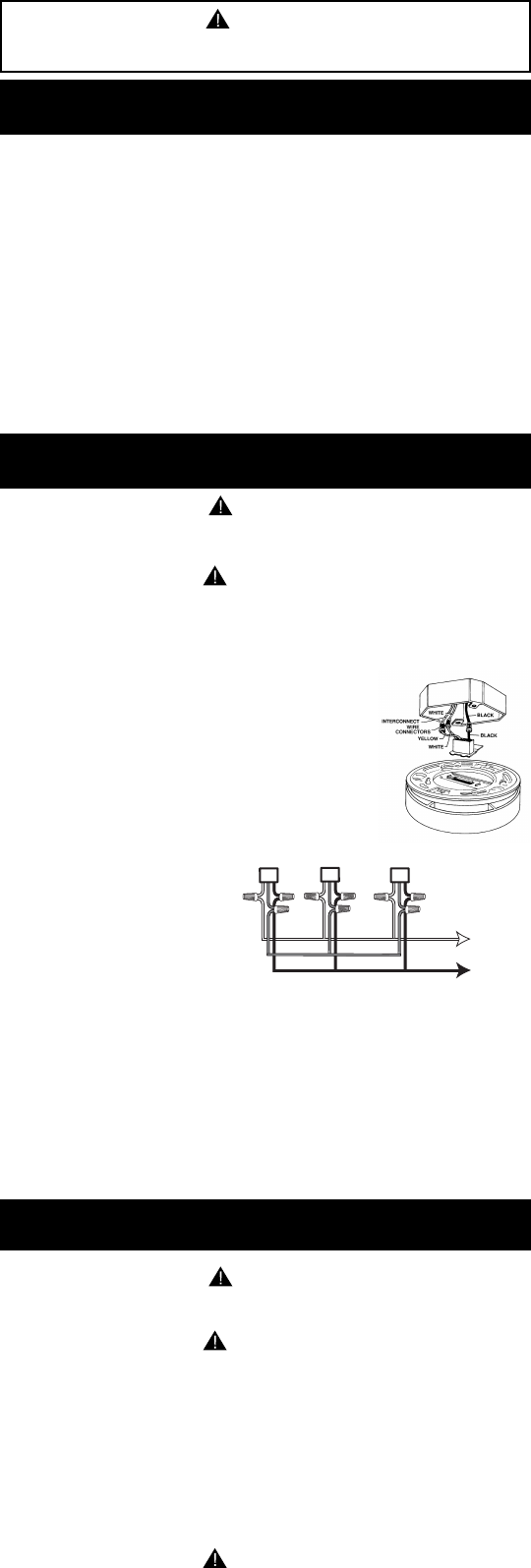
3
1. Remove the mounting plate. Hold the alarm and turn the mounting plate clockwise
to separate it from the back of the alarm.
2. Hold the mounting plate against the ceiling or wall in the desired position and use
a pencil to trace the mounting holes.
3. Use a 3/16” (5mm) drill bit to drill through the center of the outlines you made in
Step 2.
4. Insert screw anchors into the drilled holes. If necessary, gently tap anchors with
a hammer until they are flush with the mounting surface.
5. Attach the mounting plate to the mounting surface with the mounting screws
provided.
6. Position the alarm on the mounting plate and turn clockwise to lock it into place.
7. Pull out the battery activation strip. The alarm will respond with one yellow
light flash.
8. Test the alarm. See “TESTING AND MAINTENANCE” for details.
DANGER
ELECTRICAL SHOCK HAZARD. Turn off power at the main fuse box or circuit
breaker by removing the fuse or switching the circuit breaker to the OFF position.
WARNING
This CO alarm should be installed only by a qualified electrician. Carbon
Monoxide alarm installation must be in accordance with the requirements of
Article 760 of the National Electrical Code and any local codes that may apply.
• Install CO alarm on any 4-inch or single gang junction box only.
1. From box of CO alarm, remove mounting plate.
2. Align recessed slots on plate with mounting holes
of any 4-inch or single gang junction box.
3. Gently pull household wires through center hole
of plate.
4. Secure plate to junction box using mounting screws.
5. With a small wire connector, connect white wire from
connector plug to white household wire.
6. Connect black wire from connector plug to black
household wire.
7. To interconnect alarms, connect
yellow wire from connector to
interconnect wire between other
combination or smoke alarms.
Before starting, see “INTER-
CONNECTING AC and AC/DC
ALARMS.”
NOTE: For a single-station alarm,
cover yellow wire with
electrical tape and tuck into
junction box.
8. Attach connector plug to pins on back of combination alarm. Plug will only fit
one way and will snap into place. Gently tug connector to be sure it is
attached securely.
9. Position the CO alarm to mounting plate and turn clockwise to lock into place.
10. Turn on power at main fuse box or circuit breaker.
11. Test CO alarm. See “TESTING THE CO ALARM.”
12. Model COE only: Activate the battery. Remove arrow tab and close battery
door. The yellow light will flash as door is closed.
DANGER
ELECTRICAL SHOCK HAZARD. Turn off power at the main fuse box or circuit
breaker by removing the fuse or switching the circuit breaker to the OFF position.
WARNING
This CO alarm should be installed only by a qualified electrician. Carbon
Monoxide alarm installation must be in accordance with the requirements of
Article 760 of the National Electrical Code and any local codes that may apply.
• Use #18 AWG minimum solid or stranded wire. When interconnecting, maximum
wire length between any two is 1,500 feet for #18 AWG or 4,000 feet for #14 AWG
(20 OHMS loop resistance).
• This CO alarm may be interconnected with as many as 12 other Firex model
FADC, AD, ADC, PAD, G or TCPI smoke alarms, and as many as 6 Firex model
ADH heat alarms or COE and COEA CO alarms for a total of not more than 18
interconnected devices. DO NOT connect to any other type or model combination
smoke, or CO alarm.
WARNING
While AC and AC/DC smoke, CO and heat alarms can be interconnected, ONLY
when AC power is ACTIVE will ALL units ALARM when one unit senses a haz-
ardous condition. WHEN AC power is DISCONNECTED, INTERRUPTED OR NOT
PRESENT FOR ANY REASON, ONLY AC/DC UNITS WILL CONTINUE TO SEND
AND RECEIVE SIGNALS AND SOUND AN ALARM IN RESPONSE TO THE PRES-
ENCE OF SMOKE., CO, OR HEAT, AS DETERMINED BY THE MODEL OF ALARM
THAT IS PRESENT. WHEN power is DISCONNECTED, INTERRUPTED OR NOT
PRESENT FOR ANY REASON, AC powered smoke, CO, or heat alarms WILL
NOT OPERATE.
• Connect CO and smoke alarms to a single dedicated AC branch circuit. If local
codes do not permit such a wiring configuration or connection, be sure the neutral
wire is common to both circuits or phases.
Installing AC/DC CO Alarms as Replacements with
Interconnected Legacy Firex Alarms
Model COE and COEA CO alarms are designed to be used as replacement units for all
Firex AC and AC/DC CO alarms with a low voltage interconnect line. All models listed
use a 3-wire interconnect system. To interconnect with other models, please call our
free technical support line at (800) 445-8299.
CAUTION
Do not use super glue or silicon caulk on or near the alarm! Fumes from
these products can coat and permanently damage the sensor.
FOR INTERCONNECT: USE #18 AWG MINIMUM WIRE
YELLOW
BLACK
WHITE
YELLOW
BLACK
WHITE
BLACK
WHITE
TO NEUTRAL
TO 120V AC
Interconnecting AC Only and AC/DC Alarms
Installing With a Junction Box
Models COE (10000 Series) and COEA (10400 Series)
Installing a Battery (DC) Only Stand-Alone Alarm
Model COE-B (10200 Series)
110-1125C Eng 2/22/06 11:32 AM Page 3










